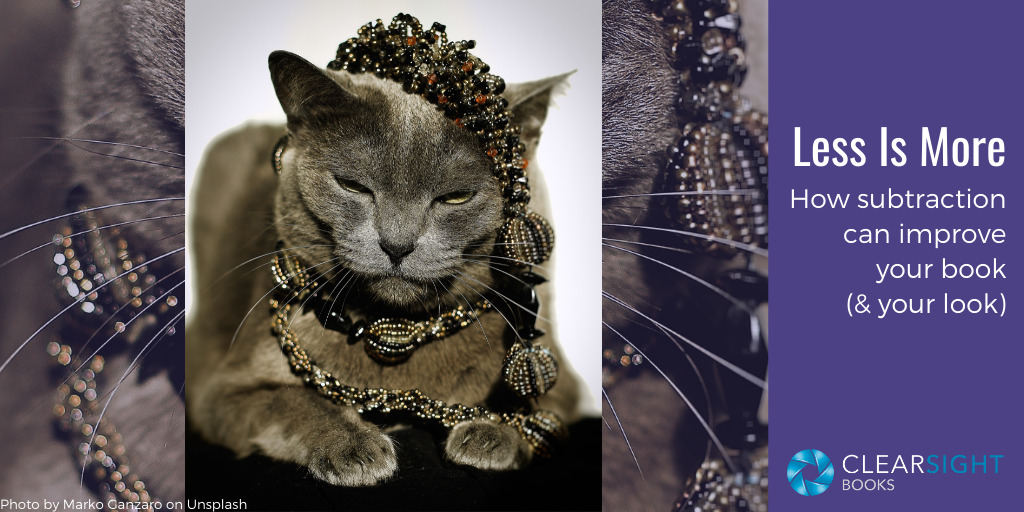
“Before you leave the house, look in the mirror and take one thing off.” —Coco Chanel
I heard this famous advice as a teenager exploring fashion and learning how to be a sophisticated, understated grown-up (hey, stop laughing) and it stuck with me (even though I’d forgotten whose wisdom it was until I consulted Google).
It’s tempting to put on all our jewelry so we can wow the world, but taking off one piece can bring our look back into balance and can even bring a pleasing tension to the picture by use of negative space.
And of course this concept of subtraction applies to writing books. (Because I wouldn’t mention it if it didn’t, right?)
Our instinct to add
In a recent Washington Post article, researchers noted that, when solving problems or looking to improve something, we instinctively try to add rather than subtract, even when adding does not necessarily bring a benefit or solve the problem any more efficiently or effectively.
- To improve our vacation, we add more activities. As a result, we end up exhausted and needing a vacation from our vacation.
- To improve our software, we add more features and functionality. With every update, Microsoft adds more clicks and visual clutter to Word, making it less ergonomic and harder to use.
- To improve our business, we add new products and services, leading to customer confusion and choice overload.
Subtraction, though, can offer benefits:
- Sheena Iyengar’s famous jam study showed that having fewer flavor choices (six versus twenty-four) led to a higher likelihood of purchase.
- Children with fewer toys (four versus sixteen) show more development and creativity.
- Coach Denise Hedges recently wrote that when her business feels bogged down or uninspired, she assesses her business to determine what to eliminate; pruning brings back inspiration and vitality.
So, how does this concept apply to writing a book?
Subtraction in your book
Writers spend a lot of time focused on addition—generating enough words to be a viable book. But once you’ve got a draft, revision and editing entail a good dose of subtraction. As you work to improve your book, look for subtraction opportunities at these four levels:
- Book concept – What is your book’s essential concept? You can’t cover everything, so boil it down. Clarity of concept makes it more apparent who your book is for and what problem you are solving, thus making it an easier purchase decision.
- Book content – What topics are covered? Identify need-to-know versus nice-to-know information. Consider how much detail you need on each topic. If you use anecdotes as a teaching device, does the reader need all of them, or are you trying to cram in a few extra just because you like them? Clarity on content results in a shorter, more focused book that is less likely to overwhelm readers.
- Book structure – Look for ways to create a consistent structure across chapters. This could entail filling gaps, but it also might include cutting something from one chapter you haven’t included in others. And unless repetition is needed for reference, look for ways to streamline the structure. For example, do you need both chapter summaries and lessons learned? Clear, consistent structure helps avoid confusion so readers stay grounded.
- Sentence-level editing – Prune your language. Concision brings more life to your writing, keeping readers better engaged.
In a nutshell, skillful subtraction results in a more impactful book. (Need some practice? Take a poetry class, where part of the focus is on compression of language for maximum impact.)
Make subtraction an option
Subtracting in a book takes practice, and it isn’t always easy. Knowing what to cut and what to keep means getting inside your reader’s head to understand what they need, and you’ll have to cut the occasional “darling” that they don’t. But the researchers noted in the WaPo article tell us we can develop better solutions and improvements by:
- taking time to think (allowing space for a greater variety of ideas and solutions),
- giving an issue our undivided attention (avoiding distractions), and
- simply reminding ourselves that we can subtract as well as add.
Just as taking off that extra bling dials your look from garish back to sophisticated, subtracting your “darlings” can help take your writing from overdone to elegant.
I love editing because it lets me subtract to my heart’s content. Need help seeing the extra bits to carve away? I might be able to help. Get in touch at karin@clearsightbooks.com.
Related reading
- Revision: What to Cut, What to Keep
- Revision: You Mean I Don’t Have to Get It Right the First Time?
- Developmental Editing: A Handbook for Freelancers, Authors, and Publishers by Scott Norton — If you’re interested in learning more about concept and structure, I highly recommend this book from the University of Chicago Press.

